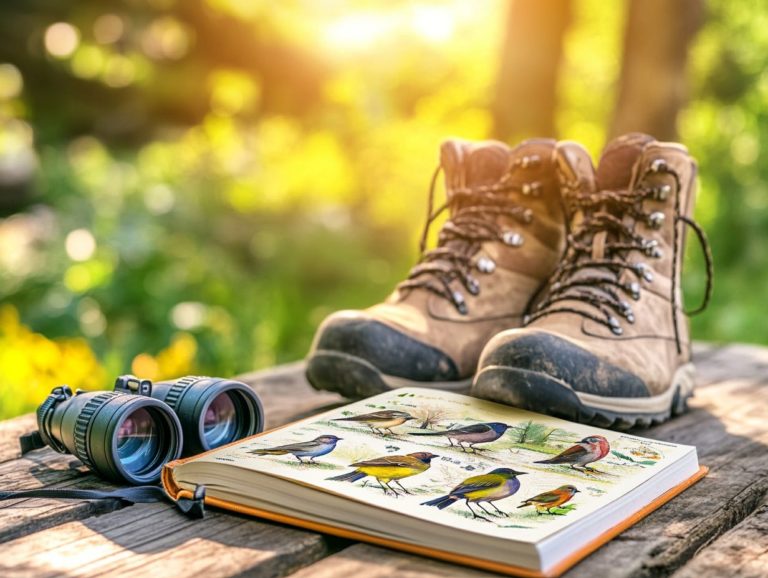Understanding Bird Identification with Field Guides
Bird identification is not just a hobby; it s a fulfilling journey that immerses you in the wonders of nature and deepens your appreciation for the rich tapestry of avian life.
Accurate identification is crucial for birdwatchers, conservationists, and casual observers. In this article, discover the significance of recognizing various bird species, the invaluable role of field guides, and practical tips to enhance your identification skills.
By understanding key characteristics and avoiding mistakes, you ll gain the knowledge necessary to embark on your birdwatching adventures with confidence.
Contents
Key Takeaways:
- Accurate bird identification is crucial for understanding and protecting our feathered friends.
- A well-chosen field guide can be a helpful tool for identifying birds in the field.
- Developing bird identification skills takes practice, patience, and a willingness to learn from mistakes.

The Importance of Bird Identification
Bird identification is an essential skill for both novice and expert birders. It elevates your birdwatching experience and plays a significant role in conservation efforts across North America.
When you accurately identify birds, you open the door to appreciating their diverse behaviors, songs, and habitats. This not only deepens your connection to nature but also enriches your wildlife observation.
By honing this skill, you can engage in citizen science initiatives that monitor bird populations, which is essential for understanding ecological shifts and developing effective conservation strategies.
Why Accurate Identification Matters
Accurate bird identification is vital for enhancing your own birdwatching experience and contributing to larger ecological studies and conservation initiatives.
Learning to recognize various species by their unique behavioral field marks fosters a deeper appreciation for avian life, including their distinctive songs and migratory patterns. Observing how different birds interact with their environments reveals the reasons for behavioral changes, especially during migration seasons.
Getting involved with local birdwatching communities enhances this journey. Sharing knowledge and discoveries cultivates a sense of collaboration. Collectively, these efforts not only benefit you as a birdwatcher but also play a critical role in preserving biodiversity and maintaining healthy ecosystems.
Using Field Guides for Bird Identification
Field guides are your best friends on the birdwatching journey! They offer rich descriptions, vibrant illustrations, and effective identification techniques that streamline the process of recognizing birds across North America.
Whether you re drawn to the Sibley Guide, Peterson Guide, Kaufman Guide, or the Crossley ID Guide, each resource presents a unique blend of detail and accessibility, catering beautifully to both newcomers and seasoned birders.
With the advent of digital guides and innovative birding apps, you now have access to portable resources that elevate your field experience, making identification straightforward and immensely enjoyable.
Types of Field Guides

Explore the exciting variety of field guides available to enhance your birdwatching adventure! Each guide is tailored to meet diverse birdwatching needs and preferences.
Some guides prioritize portability, making them perfect for long hikes, while others embrace digital innovation, offering apps that deliver real-time updates on bird sightings. The role of illustrations is significant as well; a guide filled with detailed images allows you to differentiate between similar species with ease.
Relying solely on printed guides can limit your access to the latest information, which is a clear downside compared to digital options that can adapt and grow with user contributions. By carefully considering these strengths and weaknesses, you can select a guide that aligns with your style and enriches your experience in the field.
How to Choose the Right Guide
Choosing the right field guide is crucial for your bird identification journey. For a deeper insight, understanding the layout of bird field guides can significantly elevate your birding experience, whether you’re a novice or a seasoned enthusiast.
When selecting a guide, consider your skill level. This ensures the content aligns with your expertise. If you’re just starting out, you may appreciate resources with clear, straightforward language and captivating visuals. If you’re more experienced, you might prefer advanced field guides that offer in-depth information tailored to your interests.
The geographic focus of the guide is also vital. Many birders prefer guides that cater specifically to their local regions. A visual index can also be a game-changer, allowing quick identification and enhancing your birding adventure.
How to Identify Birds in the Field
Spotting birds in the wild is an exhilarating adventure that calls for a keen eye for various distinguishing features. Look for size, shape, color markings, and behavior, which are essential for successful birdwatching across diverse habitats.
By honing in on field marks distinctive traits like beak shape and wing patterns you can significantly boost your accuracy in recognizing different species. Incorporating bird call identification into your toolkit can elevate your skills even further.
Paying attention to the bird’s habitat and seasonal variations can enhance the identification process. This transformation will turn birdwatching into an unforgettable adventure!
Key Features to Look For
When identifying birds, prioritize several key features: field marks, size and shape, and color markings. Each element plays a crucial role in the identification process.
Field marks, like unique patterns on feathers or distinct markings on wings, serve as definitive clues for distinguishing species. Don t underestimate the importance of size and shape; these traits allow quick assessments of a bird’s identity, especially from a distance.
By carefully observing these traits, you enhance your chances of accurate identification and cultivate a deeper appreciation for avian diversity. Paying attention to behavioral traits, such as feeding habits or flight patterns, enriches your experience, providing valuable context.
Common Mistakes to Avoid

Even experienced birders can fall into common traps when it comes to bird identification. This problem affects both newcomers and seasoned birders, often due to an over-reliance on specific techniques or overlooking crucial field marks.
One prevalent mistake is fixating too heavily on color variations. This can be misleading, as lighting conditions or seasonal plumage changes can dramatically alter a bird’s appearance. If you neglect other vital characteristics like size, shape, and vocalizations you may find yourself making misjudgments.
Adopting a holistic approach to observation, incorporating all available cues, can significantly enhance your identification skills. Understanding the nuances of bird behavior and habitat provides critical context, greatly improving your accuracy in field identifications.
Tips for Improving Bird Identification Skills
Enhancing your bird identification skills demands a blend of practice and patience, along with a commitment to ongoing learning. Exploring a range of birdwatching tips and utilizing available resources can elevate your understanding of these remarkable creatures.
Practice and Patience
The cornerstone of effective bird identification lies in consistent practice and the patience to observe and learn. This approach allows both novice and expert birders to refine their skills over time.
Engaging in regular field outings is key. These excursions provide very useful opportunities to encounter various species in their natural habitats. Whether you re exploring local parks, national wildlife refuges, or vast landscapes, the diverse settings enhance your birdwatching experience. Don t miss out on the chance to connect with nature!
Keeping a field journal can help you track your sightings and personal progress. Participating in community birding events fosters learning through shared experiences.
By observing different behaviors, vocalizations, and habitats, you can deepen your understanding of avian life. Each outing becomes not only enjoyable but also a vital step in mastering the art of bird identification.
Resources for Further Learning
Accessing a wealth of resources is essential for birders looking to sharpen their identification skills and deepen their understanding of avian species. Utilizing various field guides, along with using binoculars effectively for bird identification, can greatly enhance your birding experience. Popular options include the Sibley Guide and Peterson Guide.
To accomplish this, explore a variety of tools and communities that promise both guidance and camaraderie. Digital resources, such as comprehensive online guides and interactive birding apps, serve as very useful tools. They make it easy to identify species through detailed images and audio calls. Popular apps like Merlin Bird ID feature user-friendly interfaces designed for both beginners and seasoned birders.
Joining local community programs and birdwatching clubs opens the door to hands-on learning and social interaction. You ll gain insights from more experienced members and participate in group outings that enhance your observational skills.
Frequently Asked Questions

What is bird identification?
You identify different bird species based on their unique physical characteristics, behaviors, and habitats.
Why is it important to understand bird identification?
Understanding bird identification helps you appreciate and connect with the diverse bird species in your local environment. It also aids conservation efforts and contributes to citizen science projects.
What are field guides?
Field guides, such as the Kaufman Guide and Crossley ID, are resources containing information and illustrations of different bird species, their habitats, behaviors, and range maps. They are used as references to help identify birds in the wild, aiding both novice and expert birders in the identification process.
How do I use a field guide to identify a bird?
To use a field guide, start by observing the bird’s physical appearance, including size, shape, color markings, and identifying features. Then, refer to the guide’s illustrations and descriptions to narrow down the possibilities and identify the bird. For more insights on this process, consider understanding birdwatching ethics. It may take some practice, but with time, it will become easier.
Are there different types of field guides?
Yes, there are different types of field guides. General guides cover a wide range of bird species, while regional guides focus on birds found in specific areas. There are also specialized guides that focus on particular groups of birds, such as waterfowl or raptors.
Can I use technology for bird identification?
Yes! There are many phone apps and online tools available to help you identify birds. These apps feature photos, bird songs, and range maps (which show where different birds can be found) that make identifying birds fun and easy! Try apps like All About Birds and the National Geographic Field Guide as excellent beginner resources. Start your birdwatching adventure today with these amazing tools!






